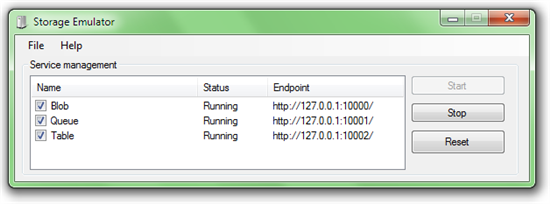本文是 Windows Azure 入门教学 的第八篇文章。
本文将会介绍如何使用 Windows Azure Drive。
我们知道,由于云端的特殊性,通常情况下,对文件系统的读写建议使用 Blob Storage来代替。这就产生了一个问题:对于一个已经写好的本地应用程序,其中使用了 NTFS API对本地文件系统读写的代码是否需要进行完全重写以便迁移到 Windows Azure平台上呢?答案是否定的。 Windows Azure平台提供了 Drive的功能。
在 1.1版本的 SDK中提供了 CloudDrive类,能够将本地 NTFS文件系统 Mount到 Blob Storage上。我们只要添加一小段代码来表明我们希望 Mount Drive到 Blob Storage上就能重用大部分已有的对本地文件系统访问的代码。这样,我们已有的程序能够无缝地迁移到 Windows Azure上而不需要做大的改动。
在开始本教学之前,请确保你从Windows Azure 平台下载 下载并安装了最新的 Windows Azure开发工具。 本教学使用 Visual Studio 2010作为开发工具。
由于我们要在本地模拟环境下测试 Windows Azure Drive,首先,请确保 Storage Emulator已经启动。我们可以找到管理器的进程手动启动或者让 Visual Studio 2010帮助我们启动他。
右击工具栏中 Windows Azure模拟器的图标,选择” Show Storage Emulator UI”。弹出如下图所示的窗口:

我们要关注的是 Service management中 Blob所在的一行。要确保 Status为 Running。
确认完毕后启动 Visual Studio 2010,新建一个 Cloud Service项目并为之添加一个 Web Role。
请在项目属性页里确认项目的 Target framework的值是 .NET Framework 4或 .NET Framework 3.5。然后在 Web Role项目中添加对 C:/Program Files/Windows Azure SDK/v1.3/ref/Microsoft.WindowsAzure.CloudDrive.dll的引用。该路径为 SDK默认安装路径,如果你不能在这个路径中找到 Microsoft.WindowsAzure.CloudDrive.dll请从 SDK安装路径中寻找。
删除并重新创建 Default.aspx 页面,然后在 Default.aspx.cs中引用命名空间:
using Microsoft.WindowsAzure; using Microsoft.WindowsAzure.StorageClient; using System.IO;
然后添加下列代码:
public partial class Default : System.Web.UI.Page
{
string _driveLetter = WebRole .DriveLetter;
protected void Page_Load(object sender, EventArgs e)
{
if (!IsPostBack)
{
Bind();
}
}
void Bind()
{
// 显示被 Mount 的 Drive 根目录下的所有文件
DirectoryInfo di = new DirectoryInfo (string .Format("{0}//" , _driveLetter));
this .GridView1.DataSource = di.GetFiles();
this .GridView1.DataBind();
}
protected void Button1_Click(object sender, EventArgs e)
{
// 在被 Mount 的 Drive 根目录下保存文件
if (this .FileUpload1.HasFile)
{
File .WriteAllBytes(string .Format("{0}//{1}" , _driveLetter, this .FileUpload1.FileName), this .FileUpload1.FileBytes);
Bind();
}
}
}
在 Default.aspx中添加下列代码:
< form id ="form1" runat ="server">
< asp : FileUpload ID ="FileUpload1" runat ="server" />
< asp : Button ID ="Button1" runat ="server" Text ="Upload" onclick ="Button1_Click" />
< asp : GridView AllowPaging ="true" PageSize ="20" ID ="GridView1" runat ="server">
</ asp : GridView >
</ form >
接下来在 WebRole.cs中引用命名空间:
using Microsoft.WindowsAzure.StorageClient;然后添加下列代码:
public class WebRole : RoleEntryPoint
{
public static string DriveLetter { get ; private set ; }
CloudDrive myCloudDrive;
public override bool OnStart()
{
// 当用配置文件中 ConfigurationSettings 时必须调用 CloudStorageAccount.SetConfigurationSettingPublisher
// 来说明当配置文件在发布后被更改时将采取何种操作
CloudStorageAccount .SetConfigurationSettingPublisher((configName, configSetter) =>
{
configSetter(RoleEnvironment .GetConfigurationSettingValue(configName));
RoleEnvironment .Changed += (sender, arg) =>
{
if (arg.Changes.OfType<RoleEnvironmentConfigurationSettingChange >()
.Any((change) => (change.ConfigurationSettingName == configName)))
{
if (!configSetter(RoleEnvironment .GetConfigurationSettingValue(configName)))
{
RoleEnvironment .RequestRecycle();
}
}
};
});
// For information on handling configuration changes
// see the MSDN topic at http://go.microsoft.com/fwlink/?LinkId=166357.
return base .OnStart();
}
public override void Run()
{
CloudStorageAccount storageAccount = CloudStorageAccount .FromConfigurationSetting("DataConnectionString" );
LocalResource localCache = RoleEnvironment .GetLocalResource("InstanceDriveCache" );
CloudDrive .InitializeCache(localCache.RootPath, localCache.MaximumSizeInMegabytes);
// 检查 Container 是否存在,不存在则创建
CloudBlobClient blobClient = storageAccount.CreateCloudBlobClient();
blobClient.GetContainerReference("drives" ).CreateIfNotExist();
// 创建 Cloud Drive
myCloudDrive = storageAccount.CreateCloudDrive(
blobClient
.GetContainerReference("drives" )
.GetPageBlobReference("mydrive.vhd" )
.Uri.ToString()
);
try
{
myCloudDrive.Create(64);
}
catch (CloudDriveException )
{
}
DriveLetter = myCloudDrive.Mount(0, DriveMountOptions .Force);
base .Run();
}
public override void OnStop()
{
myCloudDrive.Unmount();
base .OnStop();
}
}
最后,修改配置文件。在 Cloud Service项目的 ServiceConfiguration.cscfg中添加下列配置:
<? xml version = "1.0 " encoding = "utf-8 "?>
< ServiceConfiguration serviceName = "WindowsAzureDriveDemonstration "xmlns = "http://schemas.microsoft.com/ServiceHosting/2008/10/ServiceConfiguration " osFamily = "1 " osVersion = "* ">
< Role name = "WebRole1 ">
< Instances count = "1 " />
< ConfigurationSettings >
< Setting name = "Microsoft.WindowsAzure.Plugins.Diagnostics.ConnectionString " value = "UseDevelopmentStorage=true " />
< Setting name = "DataConnectionString " value = "UseDevelopmentStorage=true " />
</ ConfigurationSettings >
</ Role >
</ ServiceConfiguration >
在 ServiceDefinition.csdef中添加下列配置(注意将 Sites部分的内容删除或注释掉):
<? xml version = "1.0 " encoding = "utf-8 "?>
< ServiceDefinition name = "WindowsAzureDriveDemonstration " xmlns = "http://schemas.microsoft.com/ServiceHosting/2008/10/ServiceDefinition ">
< WebRole name = "WebRole1 ">
< Sites >
< Site name = "Web ">
< Bindings >
< Binding name = "Endpoint1 " endpointName = "Endpoint1 " />
</ Bindings >
</ Site >
</ Sites >
< Endpoints >
< InputEndpoint name = "Endpoint1 " protocol = "http " port = "80 " />
</ Endpoints >
< Imports >
< Import moduleName = "Diagnostics " />
</ Imports >
< LocalResources >
< LocalStorage name = "InstanceDriveCache " cleanOnRoleRecycle = "false " sizeInMB = "300 " />
</ LocalResources >
< ConfigurationSettings >
< Setting name = "DataConnectionString " />
</ ConfigurationSettings >
</ WebRole >
</ ServiceDefinition >
步骤三中的代码中, Default.aspx.cs的代码跟普通的 ASP.NET项目代码没什么区别。我们把盘符抽离出来以便迁移到 Windows Azure上。 Default.aspx.cs中的代码跟 Windows Azure唯一相关的一句语句就是 string driveLetter = WebRole .DriveLetter 。 我们如果把 WebRole .DriveLetter 替换为本机盘符该 ASP.NET程序将能够正常运行。
后面的代码示范了如何 Mount Drive到 Blob Storage。此外我们使用了本地缓存来缓存尚未被传递到 Blob Storage的文件。
通过上面的例子可以看到,只需额外添加一小段代码,已有的使用 NTFS API的程序能够很方便地迁移到 Windows Azure平台上。
运行程序。上传几个文件。如果一切顺利你将看到下图所示的结果。可以看到文件的 DirectoryName为“ a:/”。这就是被 Mount到 Blob Storage上的 Drive的盘符。
需要注意的是,本例中我们并未修改 WebRole的实例数,因此只有 1个 WebRole(发布到云端后将只有一个虚拟机被使用)。如果有两个实例,并且要让两个实例共享一个”网络硬盘“的话,本例中代码将不能正常工作。因为对于同一个 Blob同时只能有一个虚拟机 Mount。一个可能的解决方案是额外维护一个 Web Service来管理 Mount和 UnMount Drive。进一步的讨论超出了本教学的范围。有兴趣的读者可以下载并参考 Windows Azure Cloud Drive白皮书 获取信息。
邮箱 626512443@qq.com
电话 18611320371(微信)
QQ群 235681453
Copyright © 2015-2024
备案号:京ICP备15003423号-3
